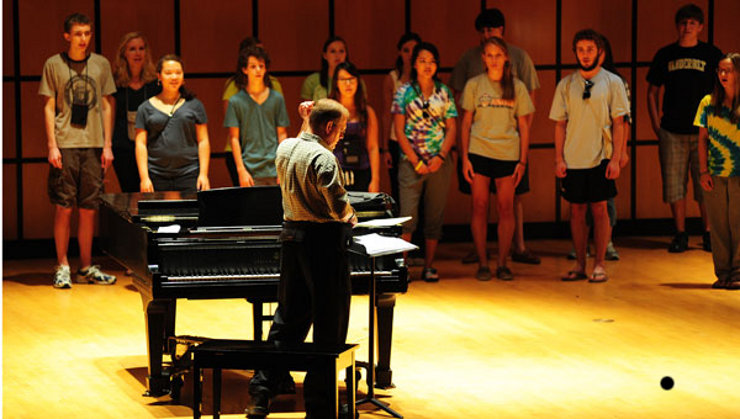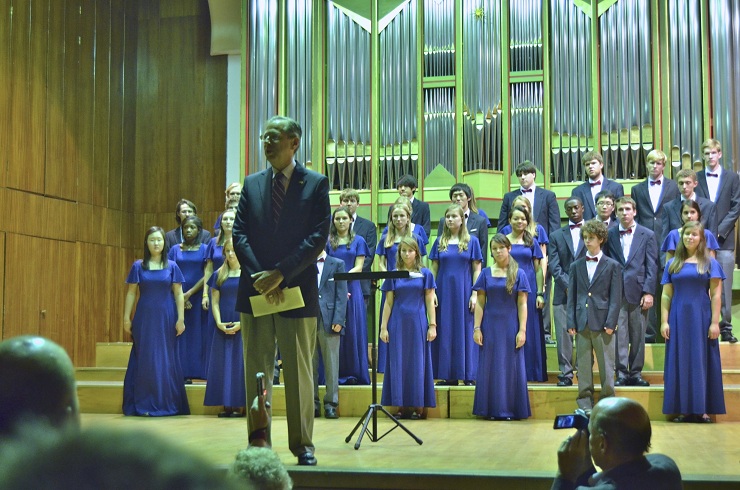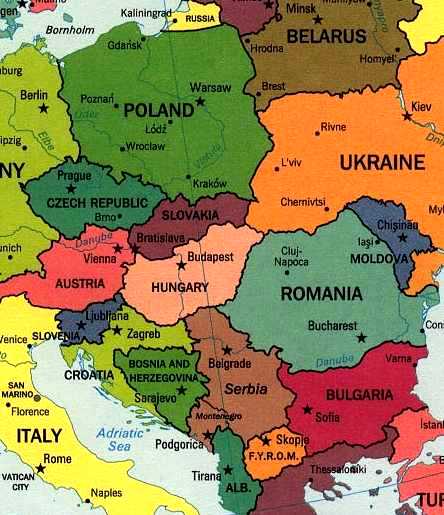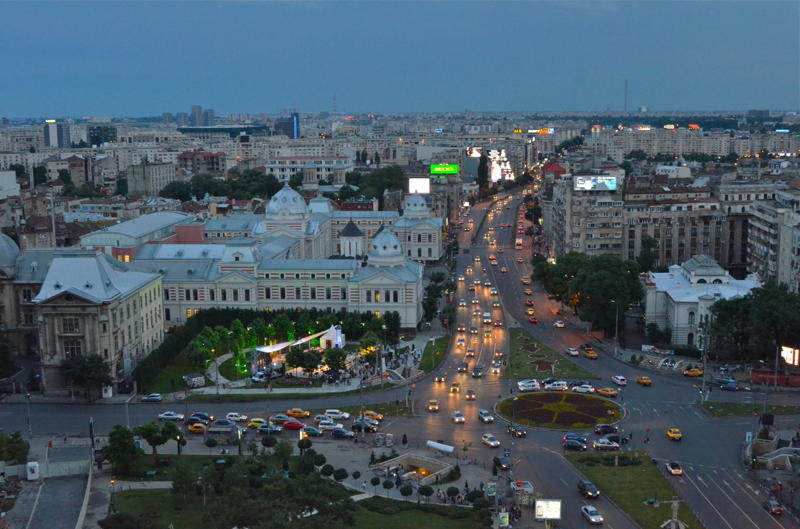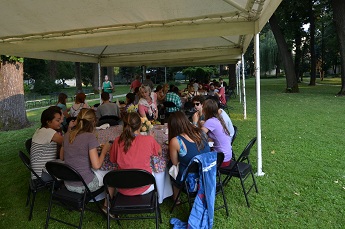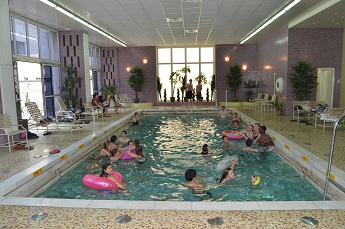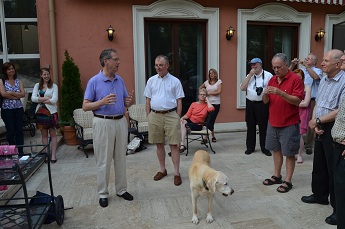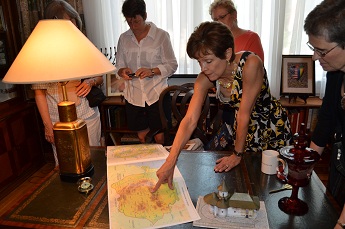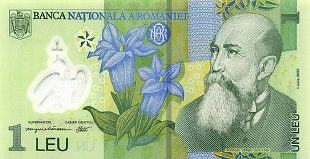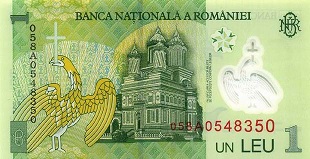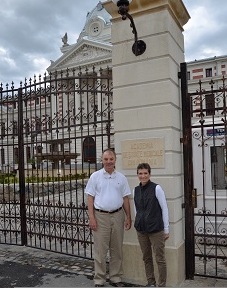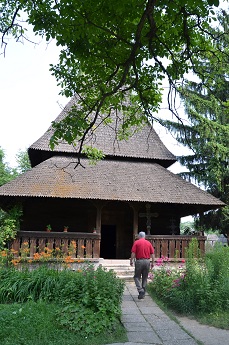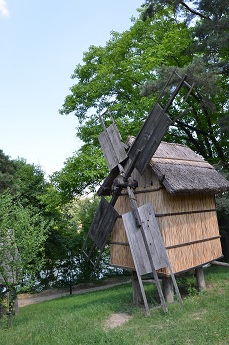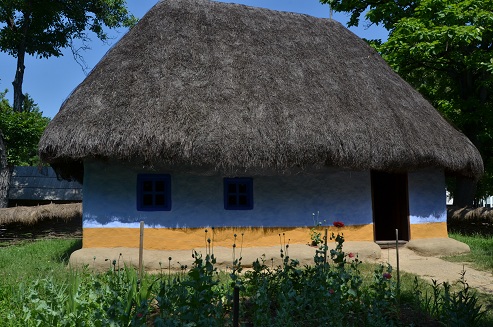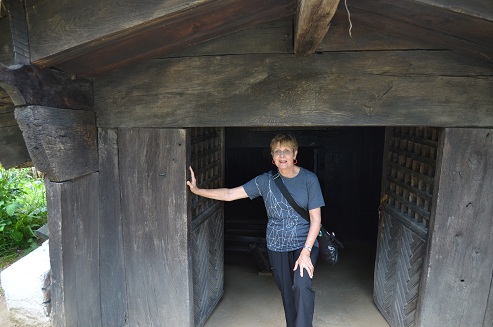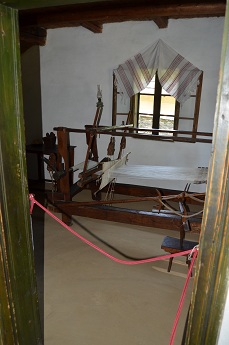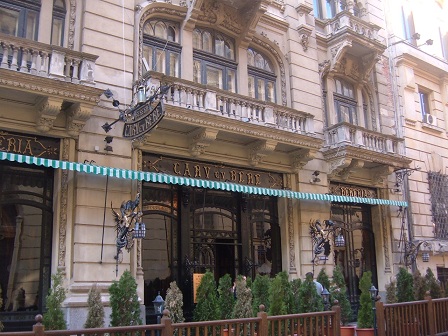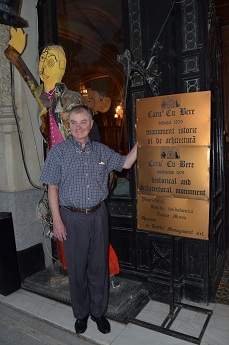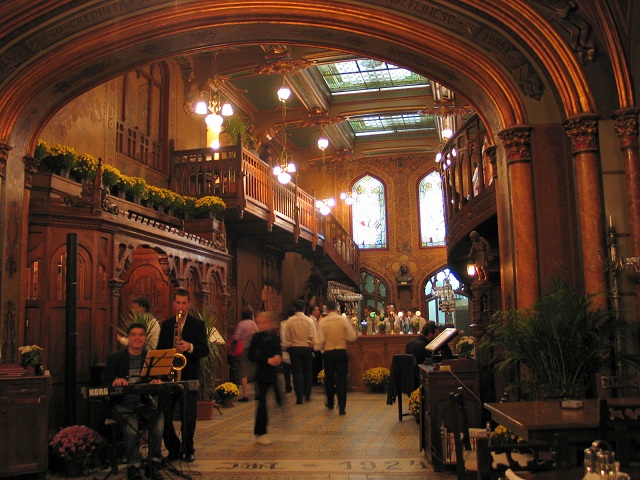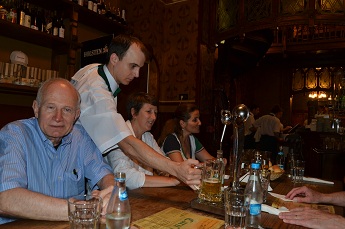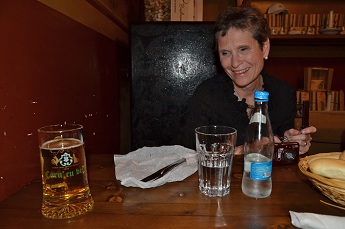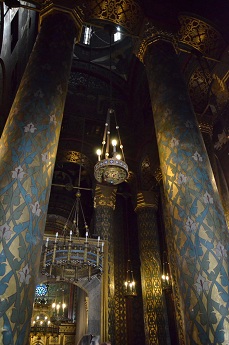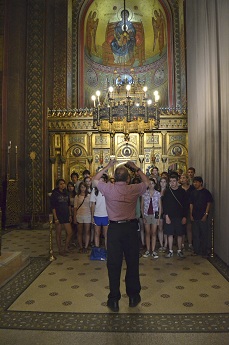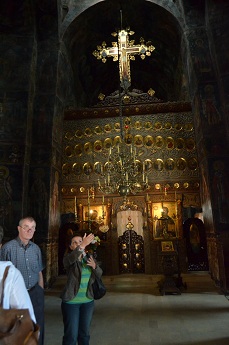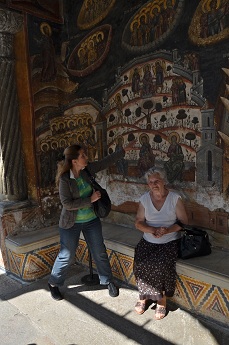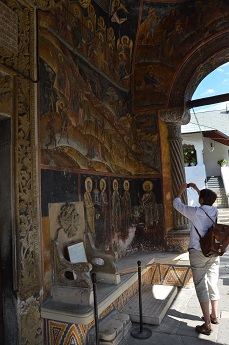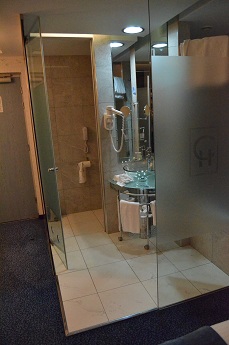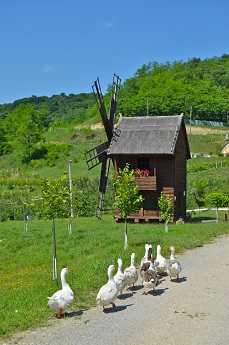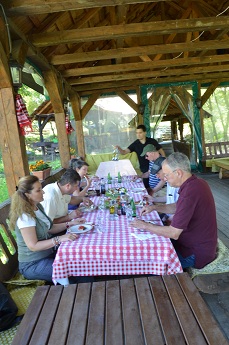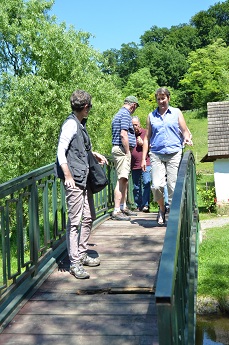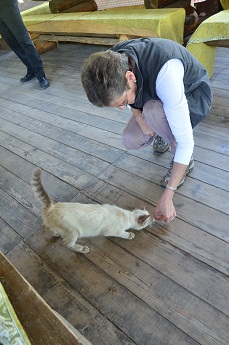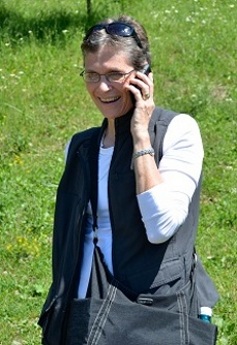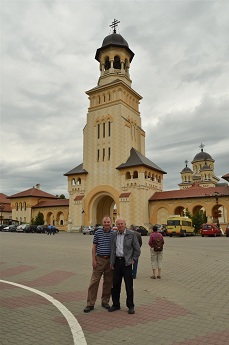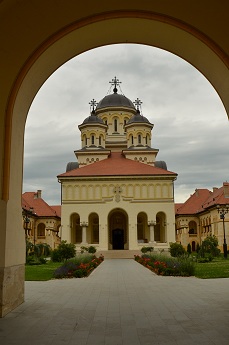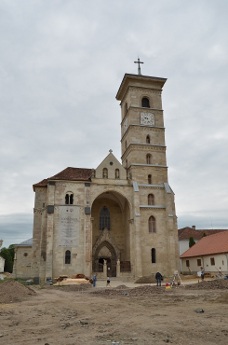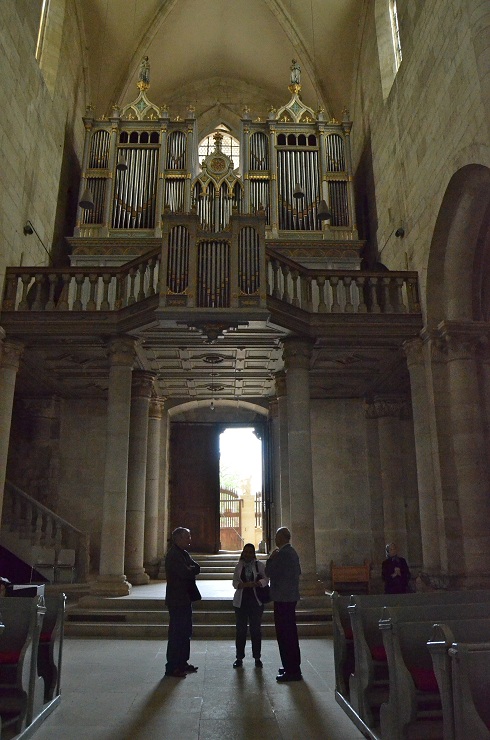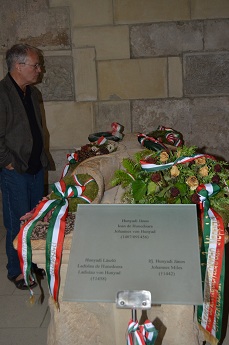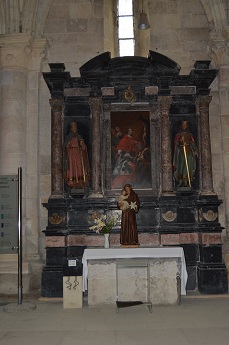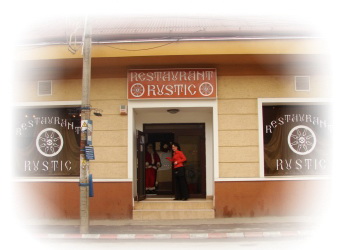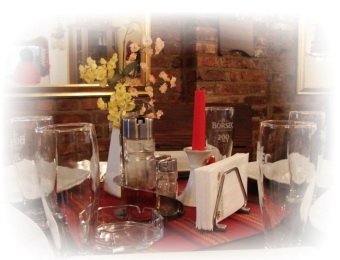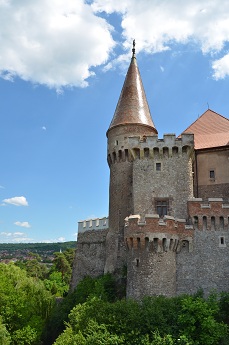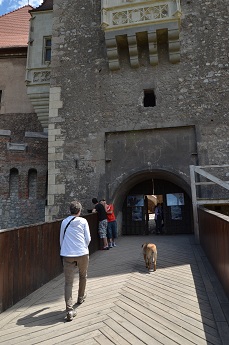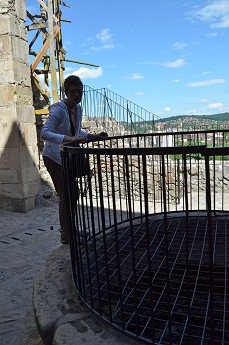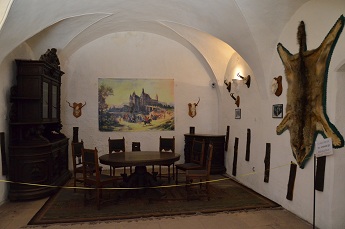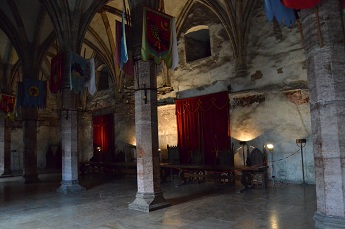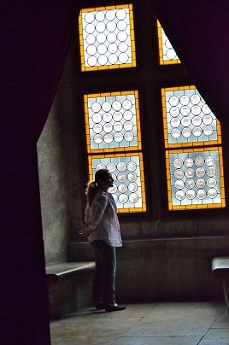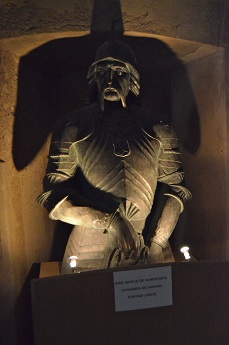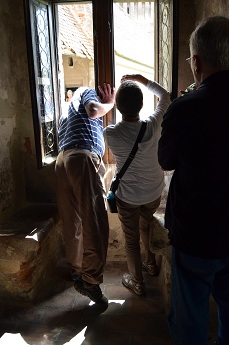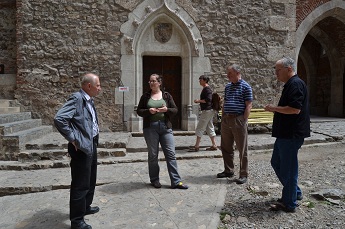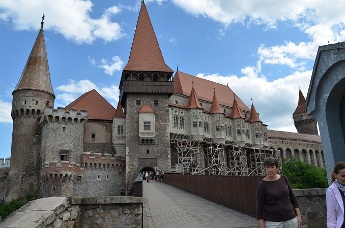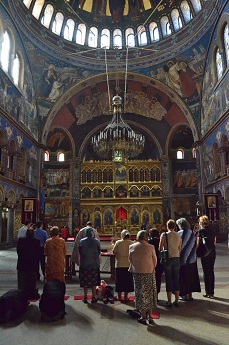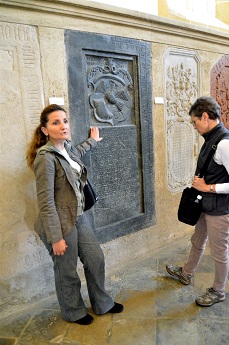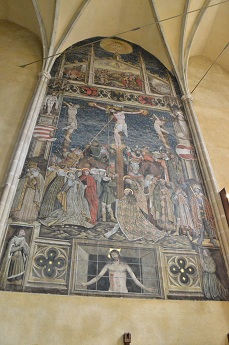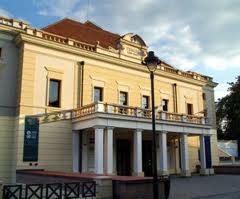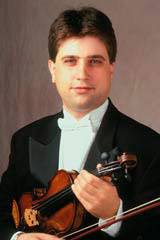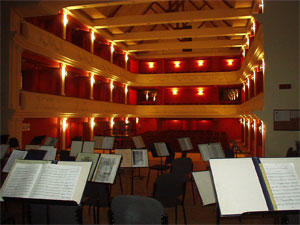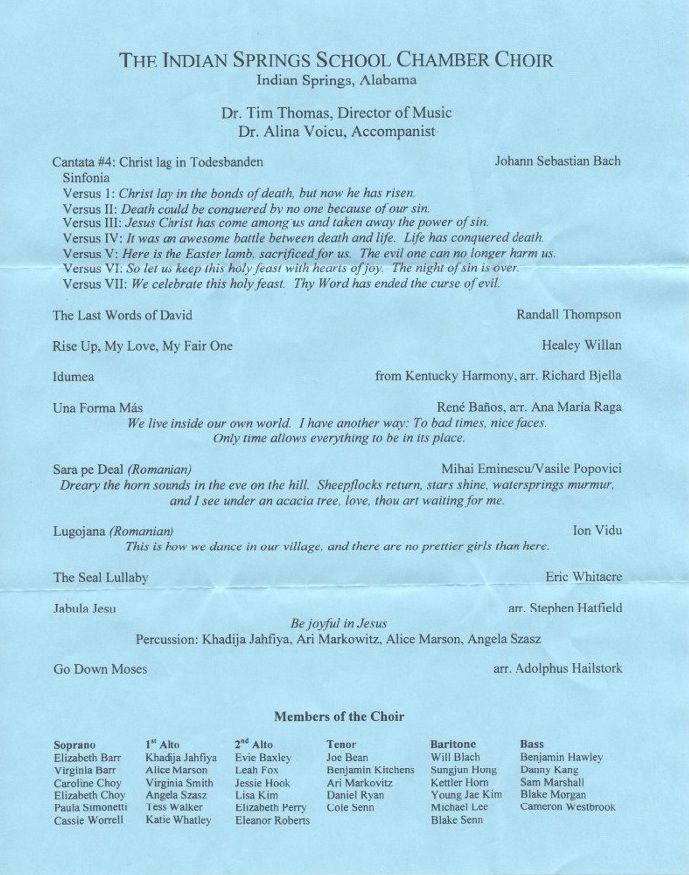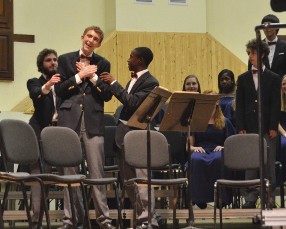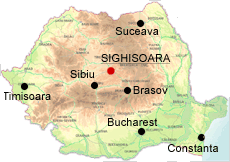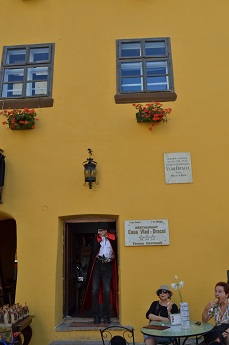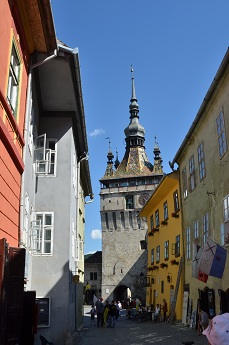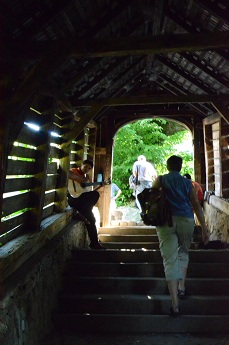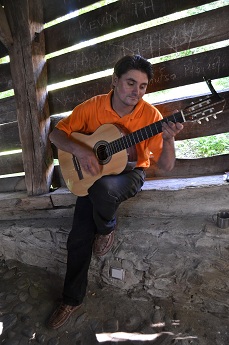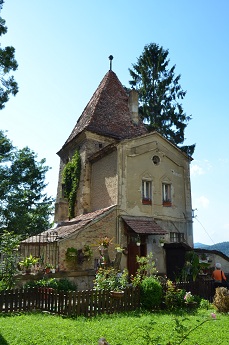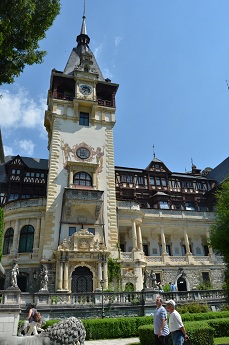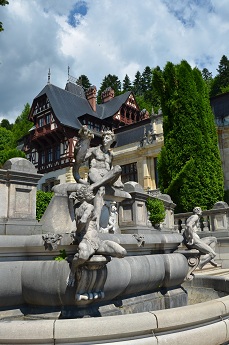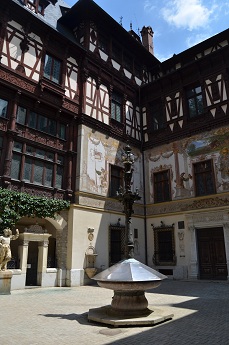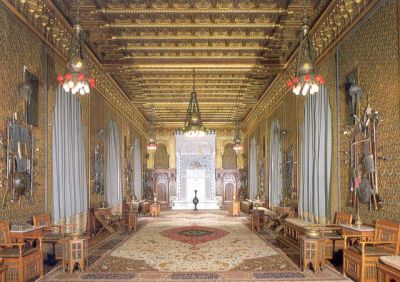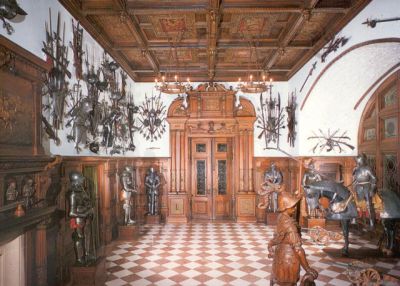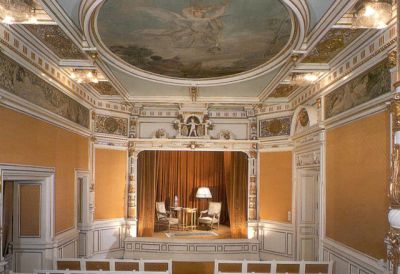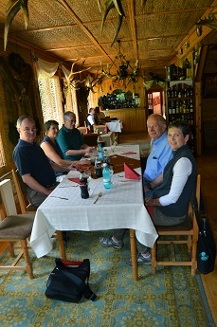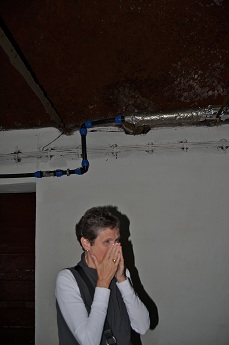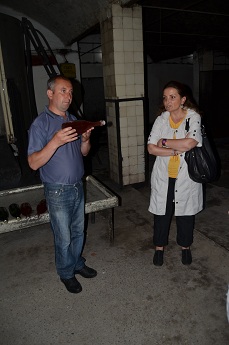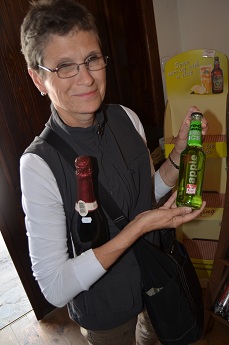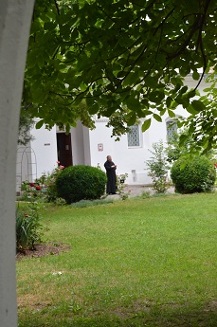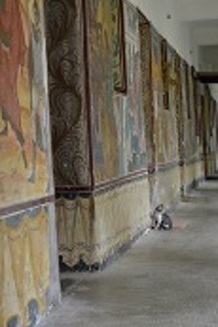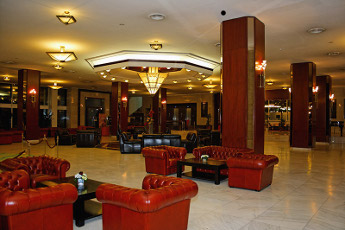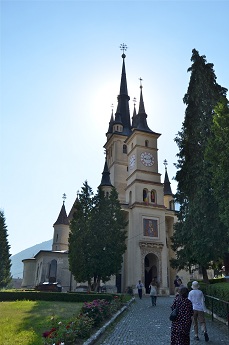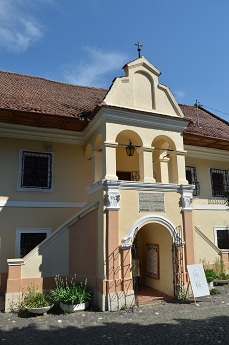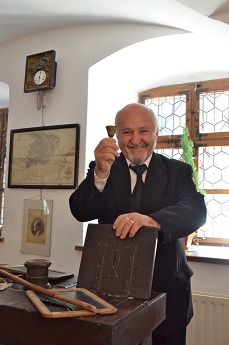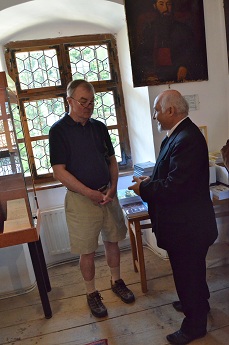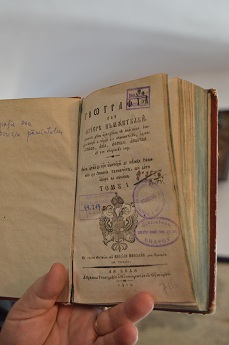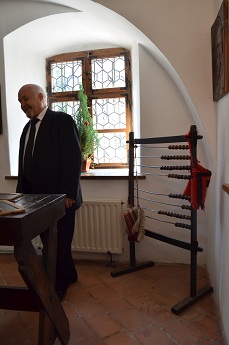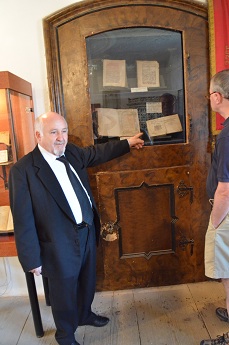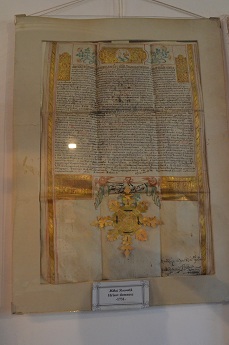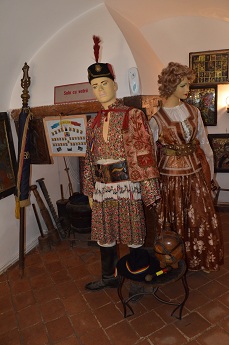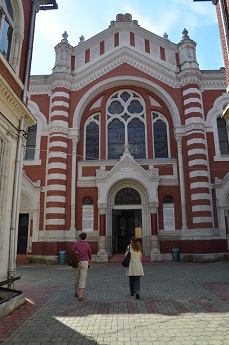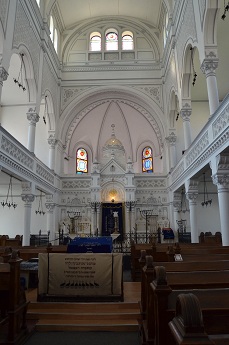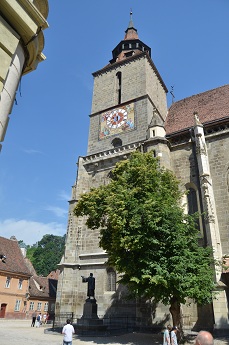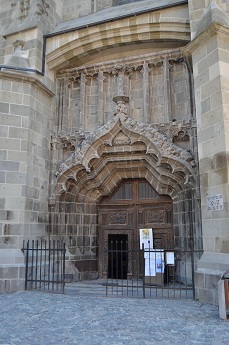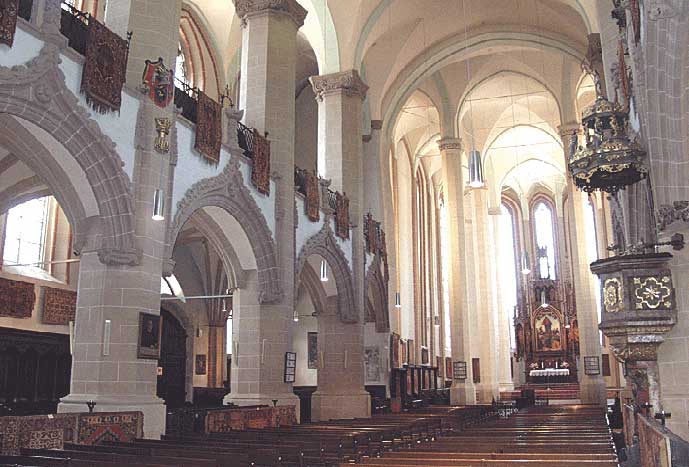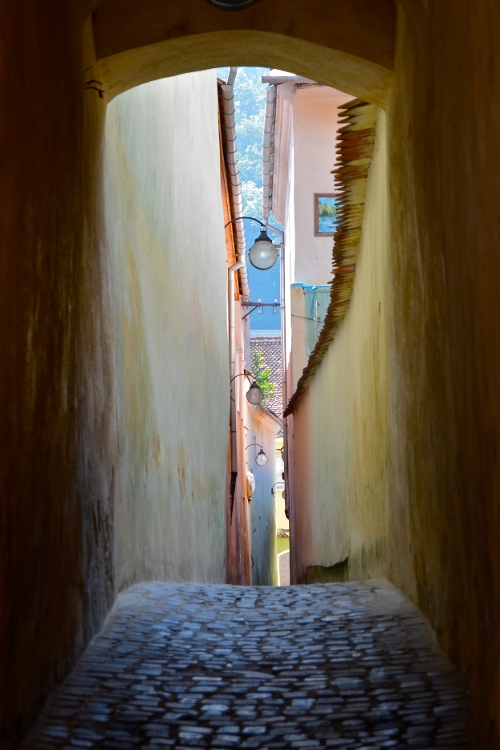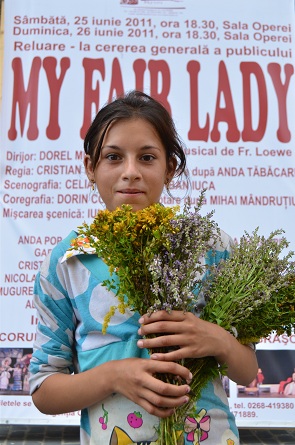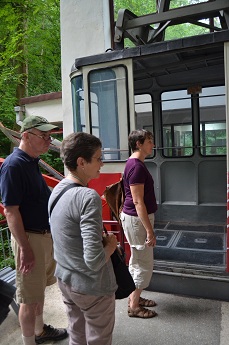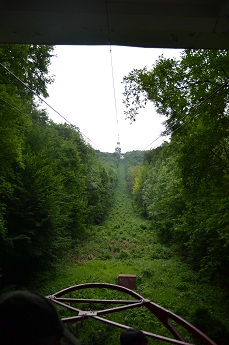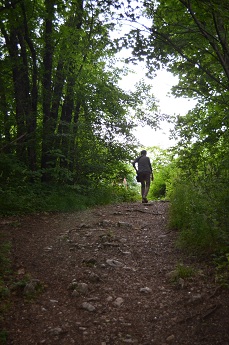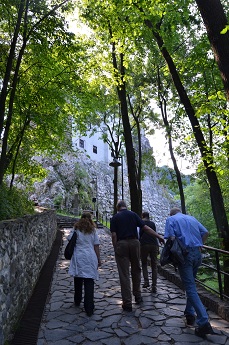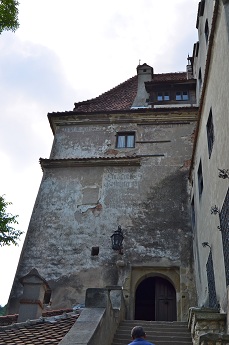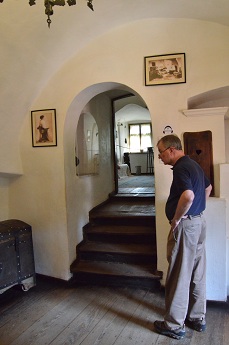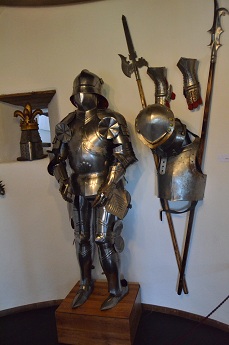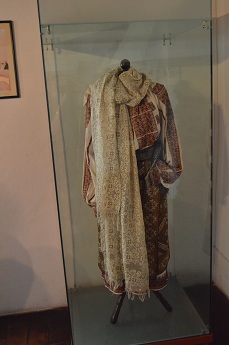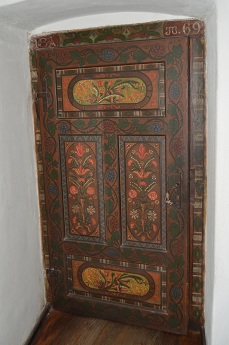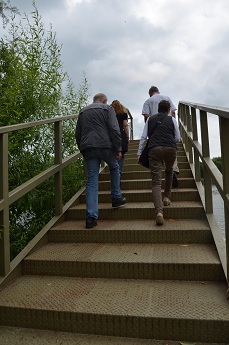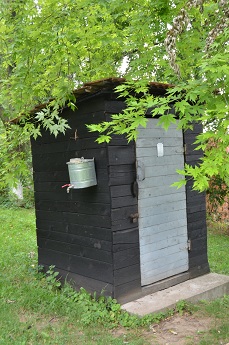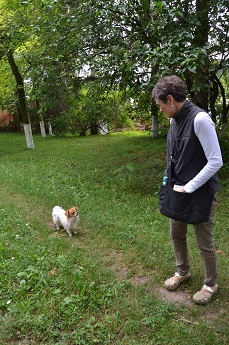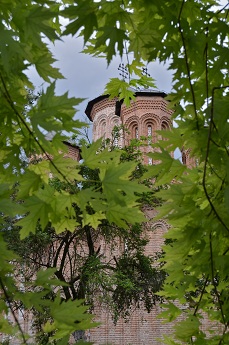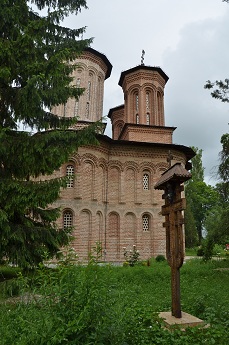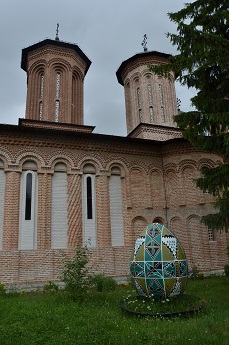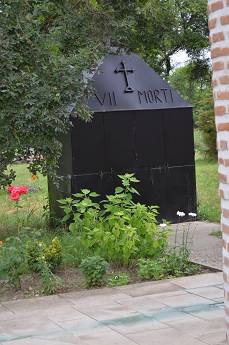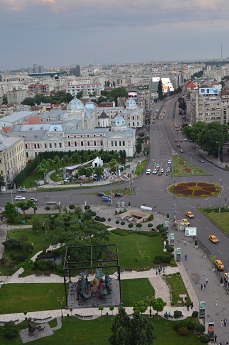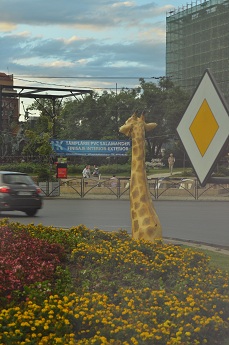Author:
Dr. Allan B. Cruse, Professor Emeritus, Computer Science and Mathematics,
University of San Francisco
ISS Alumni Tour in Romania (Summer 2011)
So what does a USF emeritus professor do during his summer vacation?
Amid woods on Snagov Island near Transylvania,
reputed burial-site of Vlad Tepes (aka "Dracula")
Well this year a small group of us who as teenagers had attended
Indian Springs School
in Alabama during the 1955-64 decade were
invited to accompany the school's 30-voice
chamber choir on its ten-day trip to tour
and perform at several sites in Romania, hosted
by U.S. Ambassador (and Indian Springs alumnus) Mark Gitenstein, '64.
Indian Springs conductor and alumnus Dr. Tim Thomas, '67, rehearses
the chorus at its Alabama campus.
Ambassador Gitenstein introduces the Indian Springs School's choral group
to its audience in Bucharest.
Most of us knew little about Romania before making this trip,
even though it's the 4th largest nation of Eastern Europe,
so the aim of this photo-blog is to share what we learned.
In area Romania is about the same size as the state of Oregon,
but in population Romania is larger than the state of New York.
Romania's biggest city, and its capital, is Bucharest, with a population
of two million, where we started
(and eventually ended) our ten-day tour. Our hotel was
the 25-floor 'Intercontinental', located at down-
town's center,
adjacent to the Bucharest National Theater,
in the district known as University Square.
Looking out over downtown Bucharest from our balcony at the Intercontinental Hotel
where we stayed 4 nights.
Although their official language is Romanian, most adults in Bucharest
under age 45
also speak French, German and English -- so
we had no communication difficulties.
Our hotel even offered guests a free copy of Romania's English-language
newspaper
Nine O'Clock -- which actually included a cover story about
our ISS Romanian tour!
It intrigued me to learn that Romania has a highly competitive
national education system,
with a reputation in Europe for
outstanding student scores on exams in mathematics and
computer science, and both Microsoft and Oracle have continued to
recruit a significant
number of Romania-trained software engineers.
And, yes, I even learned that Linux User
Groups have been meeting in at least five of Romania's largest cities.
Our ISS group's ten-hour flight from Atlanta to Bucharest included a quick
change-of-planes
at the Charles de Gaulle international airport outside
Paris, where we began hearing public
announcements in rapid-fire French,
and I overheard one of the 'Springs 10th-Graders, who'd
evidently
just taken French I, excitedly telling her seatmate: "I can understand
the numbers!"
Within just an hour after landing at Bucharest's Otopeni airport, and
checking into our hotel
for a quick shower and a change-of-attire,
we had climbed into our travel van for the short
drive to the
American ambassador's residence for an official
'welcome to Romania' reception.
Mark and Libby Gitenstein welcome us to an informal afternoon reception
at the ambassador's residence.
We are all treated to an elegant outdoor barbecue on the front lawn
-- and the teenagers enjoy a swim.
Mark and Libby answer our questions --
and explain to us how someone becomes a U.S. Ambassador.
In the aftermath of World War II a communist government took power
in Romania,
leading to the decades-long dictatorship of Nicolae Ceausescu
beginning in 1965;
he was dramatically ousted during the
'bloody Christmas' citizen uprising of 1989,
and Romania now is a democracy. It joined NATO in 2004 and the EU in 2007,
but
has retained its own distinctive currency (the Leu)
rather than adopting the Euro.
Romania's attractive monetary notes employ multiple colors
printed on a flexible
and partially transparent plastic.
The images on this one-leu bill depict a famous
Romanian professor, poet, playright and literary critic,
Nicolae Iorga (1871-1940),
who
briefly was Romania's Prime Minister in 1931-32; and the magnificent
early
16th-Century Cathedral of Curtea de Arges, which we visited on our
way to Sibiu.
But before departing Bucharest we wanted to stroll and see some of its
unusual
attractions: plazas, monuments, historical buildings,
theaters, and restaurants...
At a park beside our hotel was the National Theater,
with statues of performing clowns.
We got a photo at Bucharest's earliest hospital (Coltea)
and another at its Arch of Triumph.
The Palace of the Parliament is the world's most immense
civilian governmental structure.
The obelisk at Revolution Square honors martyrs
of the 1989 Nicolae Ceausescu revolt.
In a northern section of Bucharest bordering Herastrau Park is
the Satului Village Museum,
which exhibits an extensive outdoor
collection of authentic rural peasant houses and barns
with their traditional furnishings,
gathered from all over the Romanian countryside.
The lady with the camera here is Sharon Samford from Atlanta
to whom we are indebted for these images.
Tourists visiting Bucharest seem inevitably lured for dinner
and cold beer to Caru cu Bere, a
reknown 19th Century restaurant
on Stavropoleos Street, whose atmosphere makes it easy
for us
to understand why this Romanian city was once known in Europe
as the 'little Paris'.
Here members of our Alumni Tour group are discovering the
acclaimed amenities of Caru cu Bere.
On the highway from Bucharest to Sibiu the thirty ISS student singers
(plus a few of
their parents and teachers who acted as chaperones)
had their own bus, driver, and
tour-guide, separate from our alumni
group's van, and our two groups generally had
somewhat different
sightseeing schedules.
So we were pleasantly surprised when we
reached Curtea de Arges'
monastery to discover that they'd also arrived there only a
few minutes before us.
It was early enough in the morning that other tourists had not
yet arrived, so we alumni got to evesdrop on a spontaneous and intimate
quasi-private
choral 'performance' amid splendid,
even magical, 16th-Century cathedral acoustics.
Here Dr. Tim Thomas conducts an intimate unplanned choir-rehearsal
at Curtea de Arges.
Lots of words in the Romanian language are close enough to English
or French
equivalents so that it's often possible to figure out their
meanings with a bit of
guesswork. For example, the sign we saw
above a outdoor civic orchestra said
'filarmonica',
the title on a museum's scholarly book was 'Manual de filozofie',
and the Romanian word for soup is 'supa'.
But the Romanian alphabet has five
extra letters, making
pronunciations quite uncertain for us English speakers,
and it's
natural that all this comes to a head at mealtimes. It isn't obvious
that
'carnea de vita' means beef, or that 'pesti' means fish. And
then there are some
region-specific food items, like bear, which you
probably would not ever have
seen on a restaurant's menu in America
-- but bear was available in Romania!
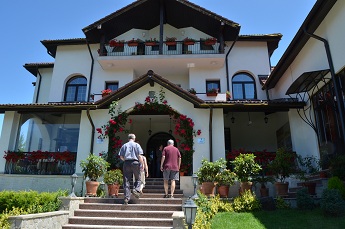
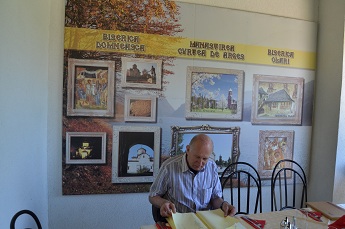
|
Stopping for lunch, away from the city, I find a menu in Romanian
isn't so easy to read.
Barely 20 miles from Bucharest is the Cozia monestary,
one of the religious
sites most visited by tourists,
erected in 1388 by the Romanian ruler known
as "Mircea the Great"
(1355-1418). He was grandfather to Vlad Tepes (aka
"Dracula") and to Vlad's younger brother (known as "Radu the Handsome").
Some of Cozia Monastery's frescoes, originally painted in 1390,
still are well preserved.
A Romanian stamp issued in 1968 bears the likeness of
the Church at Cozia Monastery.
I'd describe our hotel in Sibiu as 'ultra modern', with free WiFi
throughout and
innovative glass-walled bathrooms, punchbowl sinks,
and a frosted glass shower
stall out in the center of my bedroom.
Apparently a creative architect was given
free reign! Sadly our
busy tour-schedule didn't allow time for the hotel bowling
alley,
fitness center, sun terrace, sauna, hot tub, massage, and Balkan Bistro.
Chatting with ISS Board Member Frank Samford, '62,
upon arriving at our hotel in Sibiu.
All our hotels in Romania deployed this energy-conservation idea,
something we
hadn't yet seen in use back in the U.S., which requires
leaving a room's plastic
key-card inserted in this wall-switch in order
for the room-lights, air-conditioner
and television-set to operate (so
they automatically switch off each time you take
your key-card with you).
A bit awkward at first, but we quickly got accustomed.
An electricity-saving hotel-room card switch.
Instead of lunching at our hotel we headed out to a Transylvania farm
for a look
at the rural countryside and the animals
(although still within cell-phone range).
After a lunch in rural Romania it's possible to phone a family member
back in Alabama.
In late afternoon our Indian Springs contingents
traveled to the rural village of
Sibiel
to witness, and become participants in, a traditional Romanian
wedding
celebration, beginning with exchanges of song, food, and
street-dancing in the
village's main square.
The ISS teens got to perform again -- this time outdoors.
Here we join a rural village wedding, celebrated outdoors
with song, food, and dancing.
Everyone moved inside, as sundown approached, for a traditional
community
banquet, with an amplified band and singer, more courses
of food and drink
than we could count, punctuated by energetic
folk dancing, the local village
kids showing us how it's done,
and ultimately with the ISS kids joining in.
At their banquet in Sibiel our teens from Alabama
learn some Romanian dance-moves.
From left-to-right: Indian Springs' Headmaster Gareth Vaughan,
his wife Dorrie Fuchs,
ISS alumnus Dr. Tom Moody, M.D., '64, and ISS Development Director Beth Mulvey.
Although evidence abounds in our history textbooks that
protecting homes,
farms, and churches from hostile invaders
was an essential preoccupation
in Europe's towns and
villages for centuries, nothing brings this lesson so
vividly
to life as the chance to stroll through actual castles and fortresses
which succeeded in defending major human settlements during past ages.
Some walls 35-feet tall at this medieval stronghold near Sibiu
date from the 13th Century.
Interior of Roman Catholic cathedral at Alba Iulia
in Transylvania (from 13th-Century).
In front of the cathedral at Alba Iulia we noticed an
excavation in progress
which had unearthed several human skeletons
and other assorted artifacts.
Evidently our comments were
overheard by a young worker who relized we
were Americans
and popped up out of the pit to introduce himself. Turned
out he was a high school student from the U.S. and was spending
summer
vacation in Romania as a archeological
volunteer, an idea his mother had
suggested, he said, as a
way to enhance his upcoming college application.
A high school student from the U.S. explains some fine points
of archeological digging.
Time out for a lunch at 'Restaurant Rustic' in the university town of
Hunedoara
(which also is a tourist destination with dance clubs that are open
24 hours and
which impose no dress code, nor any entrance fee
for girls, we are informed).
Next stop on our tour was Hunyad Castle at Hunedoara, a Gothic-Renaissance
fortress built in 1409 and currently undergoing some restoration after
years of
neglect.
It features strong defense towers and a massive drawbridge,
windows
and balconies that overlook an interior yard,
a great reception room known as
the "Knights' Hall",
and a secret passage connecting the first and third floors.
Tourists are told that Vlad the Impaler (aka "Dracula")
was held prisoner here
for a period of seven years after he was deposed
as Romania's ruler in 1462.
Exploring some of the many rooms and passageways at Hunyad Castle
in Transylvania.
Back in Sibiu our walking tour takes us through the Piata Mare
(the Grand
Square) where we visited the Bruckenthal
National Museum, and where we
were reminded that this city has
a history dating back to the 12th Century.
Sibiu's Grand Square, Bruckenthal Museum, and tiled rooftops
of "old town" structures.
An iconic landmark of Sibiu is the Bridge of Lies, built in 1859
beside Piata
Mica (the Small Square) in the central city,
the first wrought iron bridge in
Romania. According to one
of several legends, this bridge will collapse if a
liar steps onto it,
so the fact that it still stands is considered a testament to
the honesty of Sibiu's citizens and merchants.
We crossed it without harm.
Our walk through the Sibiu central district takes us across its
famous "Liar's Bridge."
Two of central Sibiu's religious landmarks are its 19th-Century
Metropolitan
Cathedral (Orthodox)
and its 14th-Century Evangelical Church (Lutheran).
Our Romanian guide Ivanka explains the historical
significance of the religious edifices.
Tonight the Indian Springs Chamber Choir will perform its second concert
of
this
year's Romanian-American Music Days celebration, and the site for
their
performance is Sibiu's Thalia Hall,
a historic theater originally constructed in
1787 and then twice
rebuilt after being destroyed by fires in 1826 and 1949.
Because this building now is home to the Sibiu State Philharmonic
Orchestra,
it has a special connection to Alabama, and to Indian Springs
School, through
the person of violinist Daniel Szasz, a Sibiu native,
whose father was principal
trumpet player for this Sibiu orchestra:
son Daniel now is Concertmaster with
the Alabama Symphony Orchestra
based in Birmingham. It was Daniel Szasz
who, in collaboration with
Sibiu's orchestra, created the annual summer Music
Days national festival
with the aim of promoting active professional interactions
between
American and Romanian musicians.
Szasz's wife is Dr. Alina Voicu, the
Director of Instrumental Music
at Indian Springs School; their daughter Angela
will be on stage tonight, performing as a member of the ISS Chamber Choir.
Violinist Daniel Szasz, a Sibiu native, founded
the Music Days festival held at Thalia Hall.
At Thalia Hall the ISS Chamber Choir performs
its opening number, led by
the school's Music Director Dr. Tim Thomas,
and accompanied by the Sibiu
Philharmonic orchestra,
in celebration of Romanian-American Music Days.
The choir's program included some pieces sung in the Romanian language
as well as works from their customary American-English repertoire.
For me
it was a special thrill to hear them perform
"The Last Words of David", as it
brought back my memories of fellow chorus members from ISS when we'd
performed that piece before numerous audiences more than fifty years ago.
For this Sibiu audience, however, the pieces sung in Romanian
were their
familiar ones, especially the romantic ballad "Sara pe Deal"
by their most
esteemed national poet, Mihai Eminescu (1850-1899), in
which an Indian
Springs male soloist
sang with such impassioned gestures that his chorus-
mates
twice had to physically restrain him, much to the audience's delight.
Dr. Thomas acknowledges the choir's soloists and its pianist from ISS,
Dr. Alina Voicu.
At the conclusion of the announced program, an enthusiastic
Sibiu audience
gave the Indian Springs chorus standing ovations,
and continued to applaud
until three encores had been performed,
despite the lateness of the evening.
Sara Moody lingers to chat with audience members, then our group
departs for dinner.
Dinner at Crama Sibiul Vechi (the old Sibiu winecellar)
located at Sibiu's central plaza.
On our way from Sibiu to Brasov, where the chamber choir will give its
last
performance, we stop for sightseeing at the town of Sighisoara,
birthplace
of "Dracula", which we learn has been inhabited
since the 6th Century BC.
The town is built on hilly streets and was a military stronghold
during the
14th-16th centuries, one of Transylvania's seven
"walled citidels" fortified
for defense against Turkish
invaders.
Among its famous landmarks are the
Clock Tower, whose creaky steps we ascended for a spectacular
panoramic
view
of the town and environs, and the Church on the Hill which is
reached
by climbing a long and dark covered staircase
known as "Scholar's Stairs."
The Scholar's Stairs built in 1642 lead to a hilltop school
and to a once-Catholic Church.
Probably the most magnificent and memorable of the national landmarks
we
visited in Romania was Peles Castle, a 160-room
Neo-Renaissance palace in
the Carpathian Mountains near Sinaia,
on a medieval route which connects
Transylvania
and Wallachia. This palace was commissioned by King Carol I
(1839-1914)
and was constructed over a number of years, beginning in 1873,
at
an estimated cost of 16-million Romanian Lei in gold (worth approximately
$120-million US today). It was closed during the communist era,
but now has
been reopened to visitors (at least partially)
and is stunning in its opulence.
Exterior views of Peles Castle and surrounding grounds,
about thirty miles from Brasov.
A few of the more than 160 rooms in Peles Castle,
built at Sinaia in 1873 for Romania's King Carol I.
Only a short distance away is Castle Pelisor, built on a somewhat
lesser scale,
though still grand, by King Carol for his nephew,
King Ferdinand (1865-1927).
Behind is the restaurant where Sharon was bold enough to sample some bear.
Heading for lunch behind Castle Pelisor, built for King Carol's nephew
and Queen Marie.
And since we already were there in Romania's Prahova County wine country
anyway, to see castles Peles and Pelisor, we took some time for a guided
tour
of the century-old
Rhein Azuga winery -- including their customary "tasting".
In the Prahova Valley wine country
we tour the Rhein Azuga Wine Cellars, built in 1892.
Although in United States we are accusomed to a Constitutional
requirement
which prohibits grovernment support of established
religion, we learned that
Romania has a quite different tradition, in
which churches, monasteries, and
religious schools, do receive
public funding from the Romanian government.
Over 85-percent of the population belongs to the Romanian Orthodox Church,
and priests are selected, interestingly enough, for the quality of
their singing
voices, among other things, because the three-hour
daily Mass is largely sung
rather than spoken.
It's accepted that attendees may quietly arrive and depart
at any points during the long worship service since seating is not
assured, and
also since on weekdays many of the people will need to get to
their jobs.
This
Romanian Orthodox monastery at Lake Caldurasani, where we
stopped to visit,
is an example of successful preservation of
buildings and paintings from as far
back as the mid-17th Century,
and is a frequent pilgrimage site, we learned.
Dormitory murals
at the Lake Caldarusani Monastery depict scenes from religious history.
By now I was in awe of our Romania-born tour-guide, Ivanka, who
speaks multiple
languages, displayed a vast knowledge of
Romania's history, earned her university
degrees in psychology
and public relations, and was trained to be an opera singer!
On a couple of occasions during our van's travel between
destinations, she confided
to us some of what life had been like
growing up during the harsh and bleak era of
Romania's
communist dictatorship, what marks that experience had left
upon her
generation's life-outlook, and the important role of
music and the arts in sustaining
Romanians' treasured sense of
culture and national identity -- and an intact intellect.
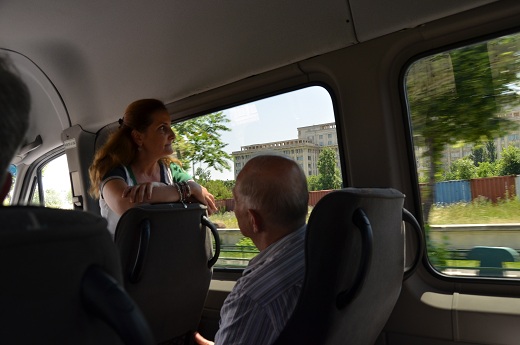

|
Our van makes an occasional "happy stop" for refreshments, leg-stretching, and gasoline refill.
We arrive at our hotel in the city of Brasov where we'll not only do
some more
sightseeing, but also attend the ISS Chamber Choir's
final Romanian concert.
I wanted to bring home, as a souvenir,
one of the attractive posters we'd seen
plastered around downtown,
announcing the ISS concert using a color photo
of conductor
Tim Thomas and the choir members, but missed my opportunity.
I did think it was interesting that our hotel had put out this red
warning-sign
near the elevators in its marble-floored lobby.
Even though we crossed paths
in Brasov with groups of tourists
from other nations, from Germany and from
Poland, for example,
the hotel's only warning-sign was lettered in English!
Our hotel's outdoor advertising was Romanian, but an indoors
warning-sign is English.
Brasov is one of the most visited cities of Romania, and numerous
sights of
interest are around the perimeter of the Piata Sfatului
(the Council Square).
Our walking tour in the medieval city of Brasov at Council Square
and Republic Street.
On the grounds of the Church of St. Nicholas in the city of Brasov
is the first
Romanian school, built in 1495, then rebuilt in 1597,
it remained in operation
as a school until 1941, but now
functions as a museum. Its caretaker for more
than 40 years
is Professor Vasile Oltean, a theologian, curator and instructor,
who gave us a short lecture in Romanian as we sat
at the early wooden desks,
listening as Ivanka, our
Romanian guide, repeated each of Professor Oltean's
sentences in English. Across the hall were displayed a number of
remarkable
artifacts, including the first Romanian Bible,
an assortment of manuscripts in
the Latin and Romanian languages,
and Romania's earliest printing press.
In Brasov we are shown the first Romanian school by its
caretaker Prof. Vasile Oltean.
Although Brasov has long been a multicultural city, and records indicate
that
Jewish traders were visiting as early as the 15th Century,
it was not legal for
Jews to actually settle in Brasov until
early in the 19th-Century. Anti-semitism
did not arise here until
1940, when the Romanian Nazi party came to power,
and although Jews
living in Brasov at that time did endure discrimination and
persecution,
we were told, few were deported and most escaped the Holocaust.
Now, though, the Jewish Community in Brasov is quite small, and mostly
elderly
we were informed, because most of the younger members have
moved to Israel.
Our Romanian guide Ivanka shows us the Jewish Synagogue in Brasov on
our city walk.
In central Brasov is Biserica Neagra ("Black Church"),
built around 1380 as
a Roman Catholic structure,
although it became Lutheran during Europe's
Protestant Reformation
under the influence of theologian Johannes Honter
whose statue
can be seen
at the side of the tower. In 1689 during the Great
Turkish War
the church was set afire and partially destroyed, a fact which
accounts for its unusual name today. Among other present-day features
is a
magnificant organ with 4000 pipes which was installed in 1839.
The Indian
Springs Chamber Choir did perform with
that organ's accompaniment, but
church officials did not
permit us to take photographs during that concert.
The ISS Chamber Choir will sing this evening at the landmark "Black Church"
in Brasov.
The Strada Sforii in Brasov, widely known as "Rope Street" because of its
narrow width, has existed since at least the 17th Century and is
believed
to have been constructed in order to give firefighters
rapid access
to the
city's Poarta Schei district, formerly a kind of "ghetto"
neighborhood for
ethnic Romanians
during an occupation of Brasov by German colonialists.
At about 4 feet, this street is too narrow for a man to
spread out his arms.
Strada Sforii is one of Europe's narrowest civic passageways.
Near Council Square in the heart of Brasov, Sharon spotted this young
lady
selling flowers to passers by on Republic Street,
apparently unaware of the
theatrical billboard on a wall behind.
(How lucky can a photographer get?)
A flower-vendor on Strada Republicii.
It's just a short walk from Brasov's Council Square to the
bottom of Tampa
Mountain, where visitors can climb aboard the cable-car
that ascends to a
woodsy mountaintop and a magnificant view overlooking
the entire valley.
Brasov's cable-car (called Telecabina de pe Tampa) got us to
Tampa Mountain's summit.
Back at Council Square as sundown approaches, we discover that the Brasov
Philharmonic Orchestra is presenting a free outdoor summer concert
for the
local citizens -- and for whoever else may happen to be
strolling past.
Nearby
is a large tent with upholstered sofas and chairs where it's
OK for us to share
some pitchers of beer and relaxed conversation
outdoors on a balmy evening.
We enjoy a little outdoor orchestral music and then some
relaxed discussions over beer.
Our next day's sightseeing takes us to what evidently is
one of the "must see"
attractions for Americans who are touring
in Romania, the landmark fortress
known as "Dracula's Castle" at
the town of Bran, which is now a museum and
is open to the public.
Permission to build the castle was granted in 1377, and
only briefly was it captured by Vlad Tepes ("Dracula") in 1457 during a raid.
We take a tour inside Castle Bran, a fortress
commonly known as "Dracula's Castle".
It is believed that Vlad Tepes, Prince of Wallachia, was killed and buried
at
Snagov Monastery in the mid-15th Century following a battle with a
unit of
elite Christian warriors from Turkey, known as Janissaries,
and that Vlad's
head was severed and taken back to Constantinople,
preserved in honey, as
proof that indeed he was dead. We were
told that the Romanian government
in 2002 had decided to build a
Disneyland-style theme park at Snagov, to be
called "Dracula's Park",
but that these plans were cancelled in 2006. So, of
course, we wanted to
inspect this dramatic site before leaving Romania.
"Dracula's tomb" is at Snagov Monastery, situated on an island
accessible via this footbridge.
The beheaded corpse of Vlad Tepes is supposedly entombed at
this desolate monastery.
At dinner, on our Alumni Tour's final night in Bucharest,
one of our table's three
tuxeudoed waiters snaps this posed
photo, presumably for the 'Springs archives.
We enjoy our final evening's meal at one of Bucharest's elegant
neighborhood restaurants...
...then say an early morning goodby to the city
for our departure from Otopeni Airport.
"The tour was a marvelous experience," ISS Director Gareth Vaughan said.
"It
gave our students and alumni the opportunity to see an incredible
country with a
rich history, and it offered us the opportunity to
participate in a cultural exchange
that was very special for everyone
involved, both Americans and Romanians."
Vaughan remarked that the Romanian audiences particularly appreciated that
the choir sang selections in Romanian, whether in scheduled concerts
or impromptu
performances at Romanian landmarks.
-- Fox6 TV-News, Birmingham, AL (27 June 2011)
Last updated on 10/23/2011
by ISS alumnus Dr. Allan B. Cruse, '59 (email: "cruse@usfca.edu")
